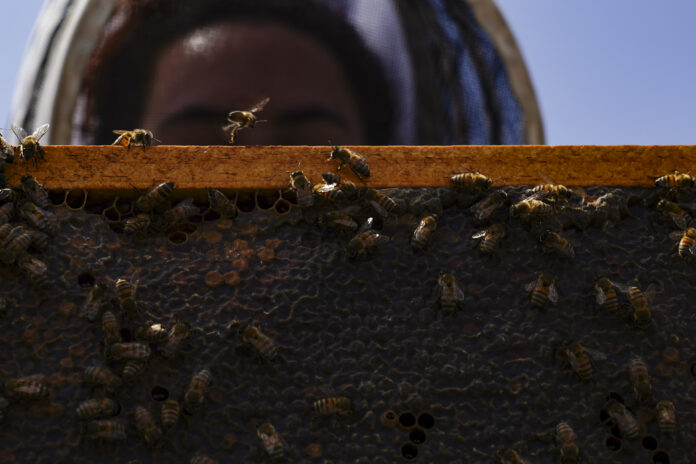
HARLINGEN — The tragic death of a 90-year-old Rio Hondo man who was swarmed by bees this week is a reminder to reconnoiter an area before working outside.
Dawn Johnston runs R9 Hive and Honey in Lyford, and part of her business is bee removal. We don’t pay enough attention to bee threats, which she says can be very apparent.
That’s if you’re looking.
“We talk to people about this all the time. We are, I’ll use this analogy, apex, right? We’re on top of the world. We don’t pay attention to things around us. We have a goal. We’re going to go do this, and this is what we do. But we don’t pay attention,” she said.
Even in your own yard, people need to be aware, especially when cutting or shredding plants, trees or bushes, or if you have things like old boats, couches or tires on the property.
“Not have a tractor running, not have a car running, no lawnmowers or weed whips,” she said. “They should just kind of walk that area first and take a really healthy look, and they would be able to save themselves a lot of trouble. Because they could go ‘Oh look, there’s the bees.’”
Johnston said a few days ago she was called out to a bee attack on workers excavating a culvert near the Mercedes fairgrounds.
“We just helped one of the water districts the other day when one of the guys in an excavator had a window that wasn’t closed, it didn’t have a front window, and he got really tore up,” Johnston said. “It was a massive hive under a culvert.”
The bees had formed a hive deep underground where several culverts converged.
“I didn’t even feel safe because it was so deep in there,” she said. “We got it, and we had to destroy the hive and we told them bury it because it was just in there so deep.”
And don’t think jumping in a pond or resaca is going to save you.
“Because the bees know where you are,” she said. “They saw you go in there, and they just hover above waiting for you to come up to breathe. And when you come up, what’s the first thing that comes up? It’s your face. They’re going to go after your face, and then you run the risk of inhaling them.”
“I think there was, in the news a couple of weeks ago, a gentleman was stung like 20,000 times, and he even had them in his lungs because he inhaled them,” Johnston said. “So jumping in the water is not going to help you, especially if you don’t have a snorkel.”
The victim of that attack last month, Austin Bellamy, 20, of Ripley, Ohio, was trimming branches while on a ladder when he inadvertently cut into a hive. He is now out of a coma and is expected to survive. He inhaled about 30 bees, doctors said.
Bees are not savage, and if you’re paying attention, will warn you before stinging. A bee buzzing around your head is the first warning, a bee smacking into you is the second.
The third is a sting.
“And then once you get stung, you’re now carrying that warning scent that any bee passing by goes, ‘Uh-oh that’s a bad problem, go sting it.’ And that just brings more and more and more. It’s a warning pheromone,” she said.
So the best advice is one, do advance scouting of the area you plan to work in before starting. Two, wear a face veil, which only costs as little as $3 or $4 dollars, and can keep your head and face protected from stings, allowing you a better chance to walk, not run, to a vehicle or inside a house.
“If you don’t have a veil on, pull your shirt over your eyes if you can,” Johnston said. “Cover your eyes with your fingers so that you can at least see out a little bit but so that your face is at least protected some.”
Perhaps the best advice is keep your yard clear of debris bees can turn into a hive.
“Don’t leave trash around your place,” she said. “If somebody throws a tire out or what-not, get rid of it. We pull more hives out of tires alongside the road than you would ever think.”



